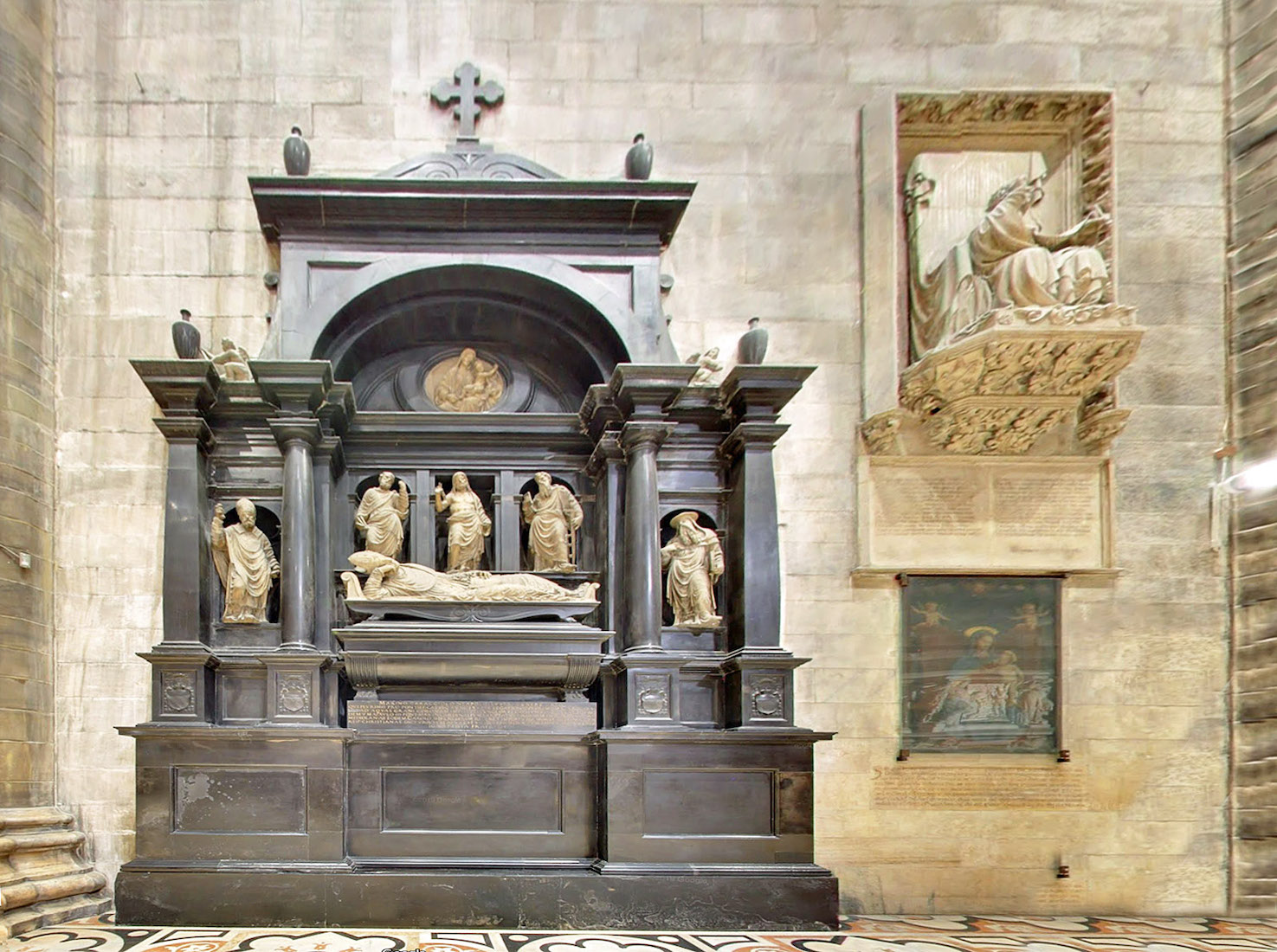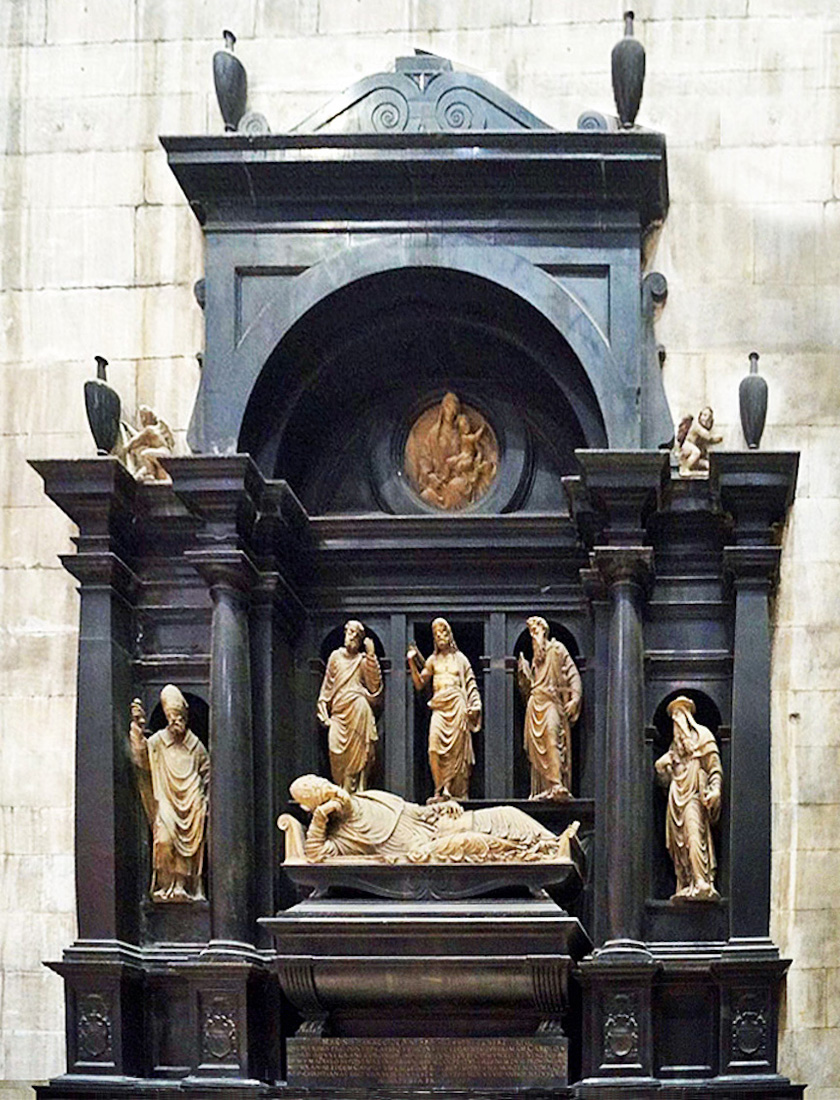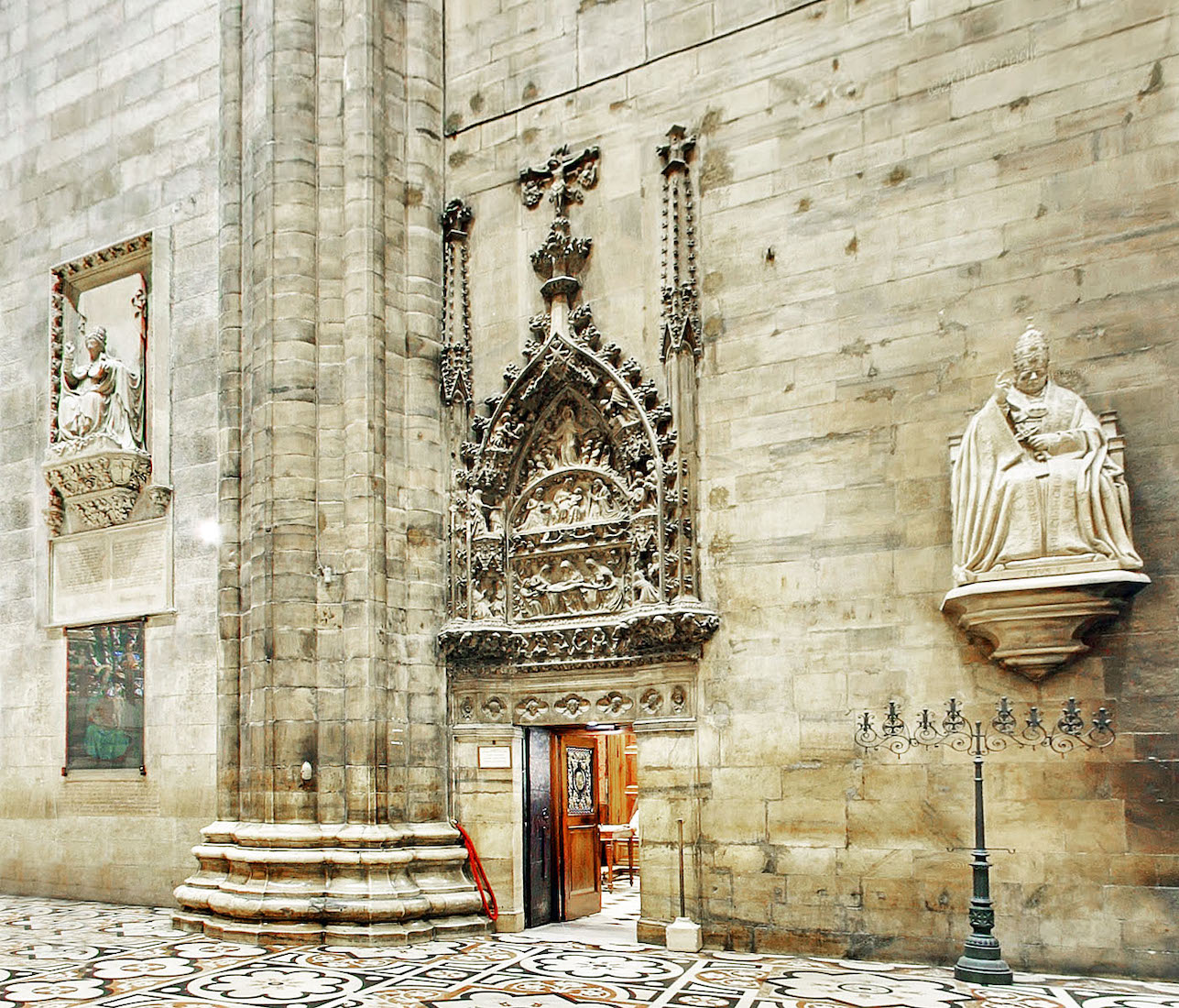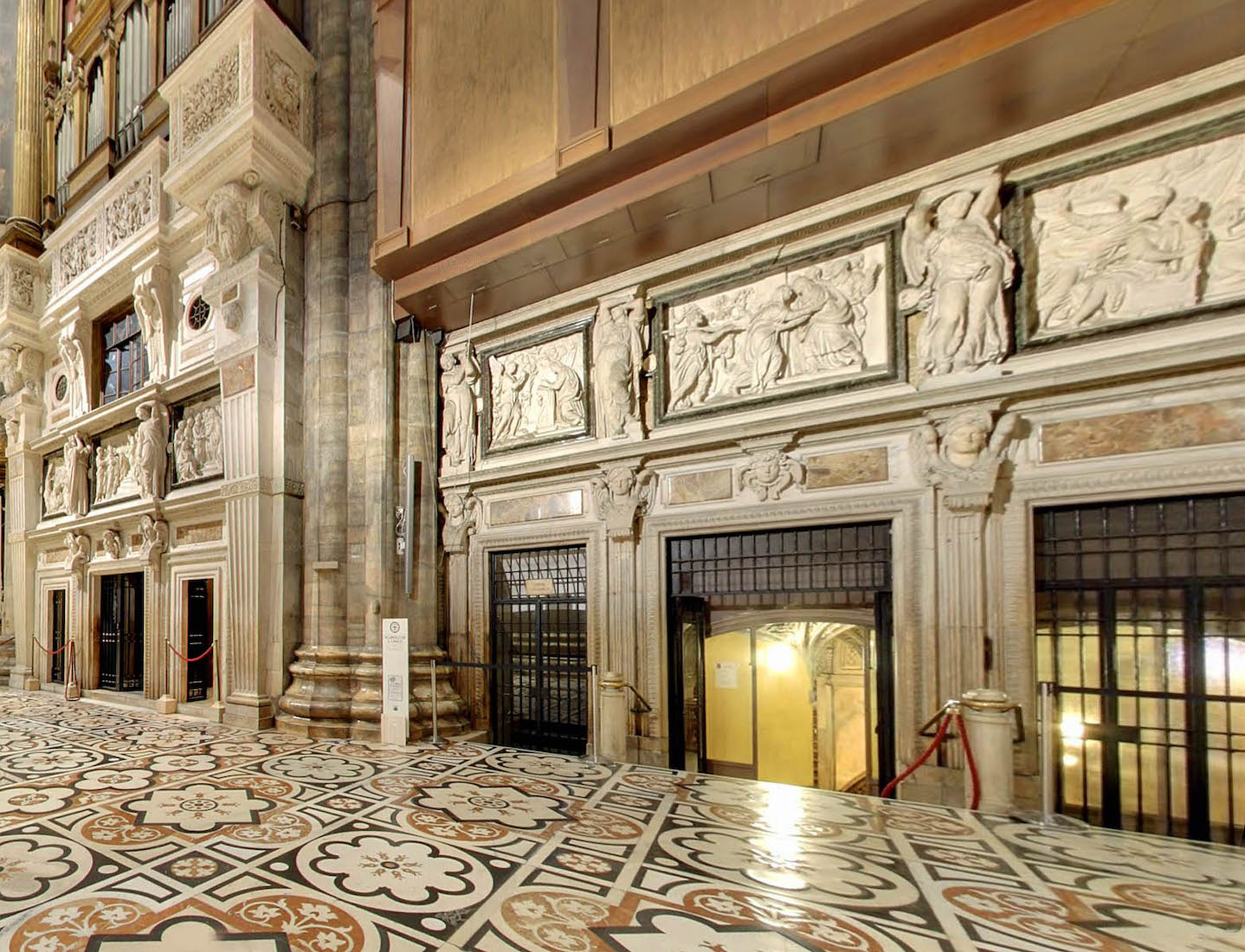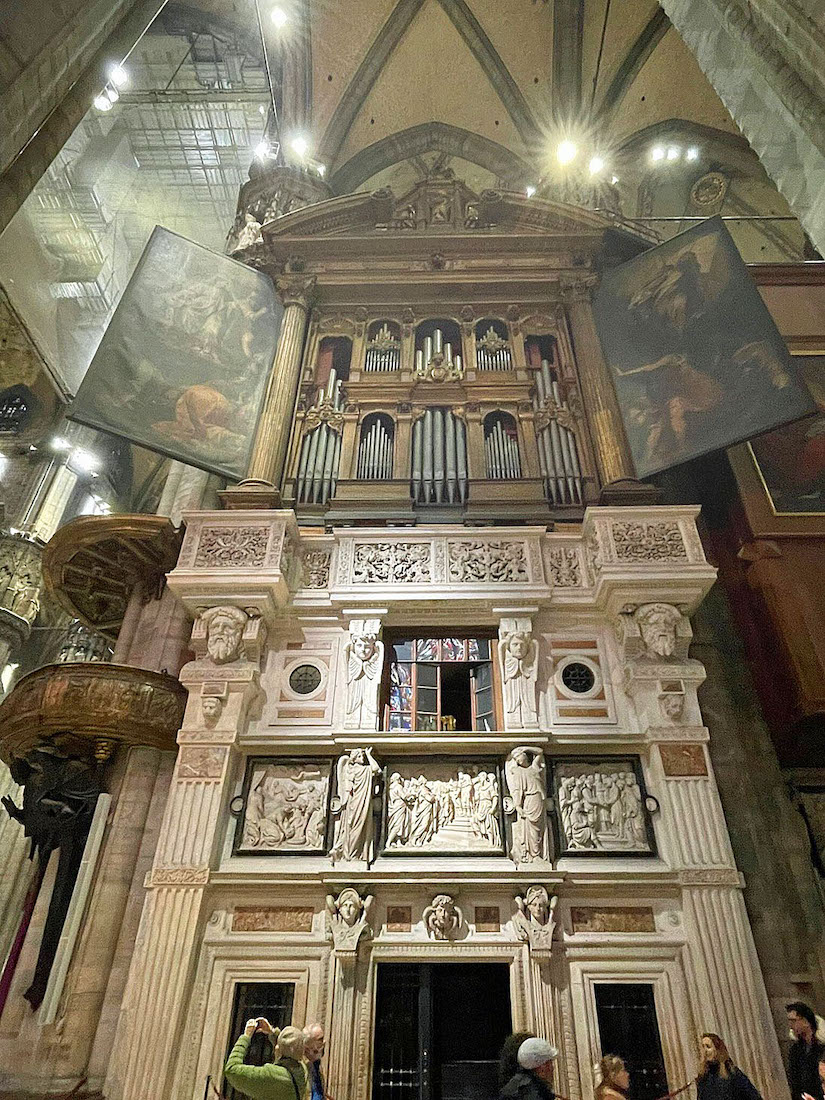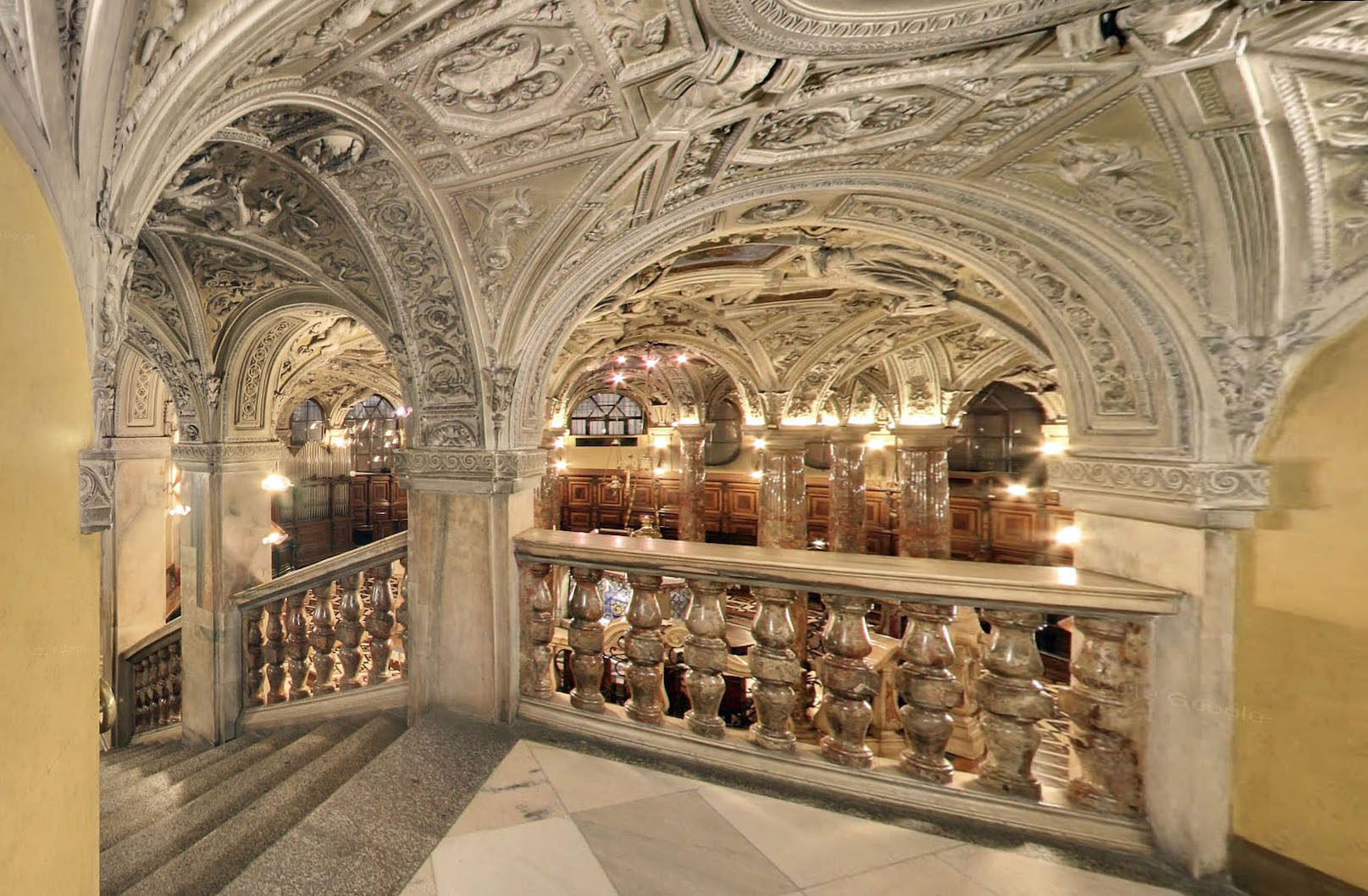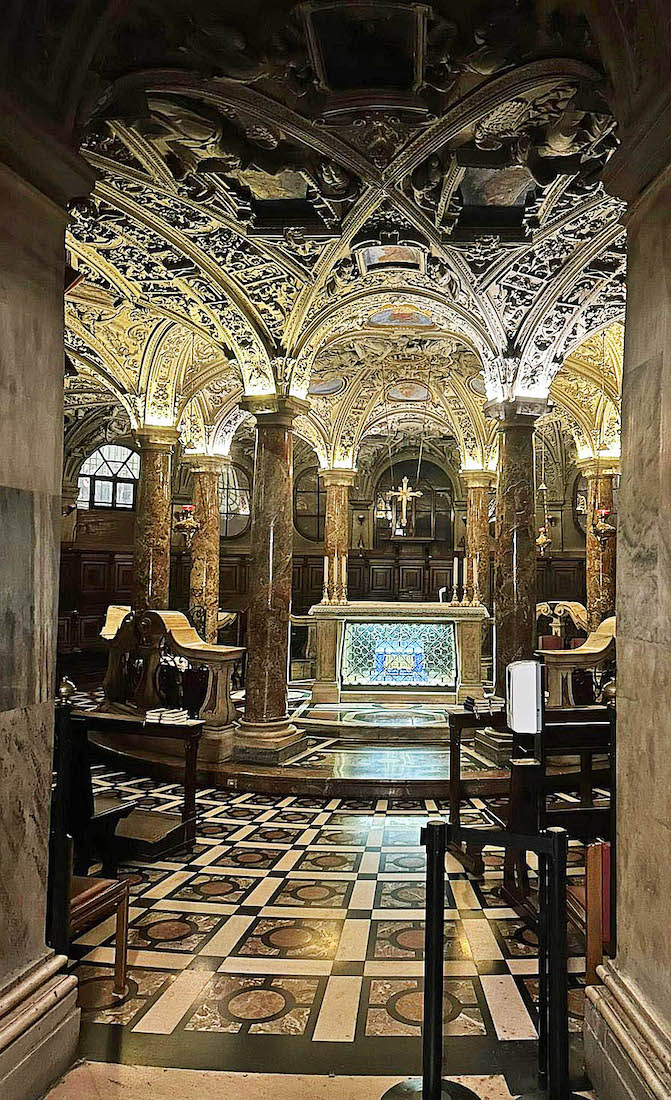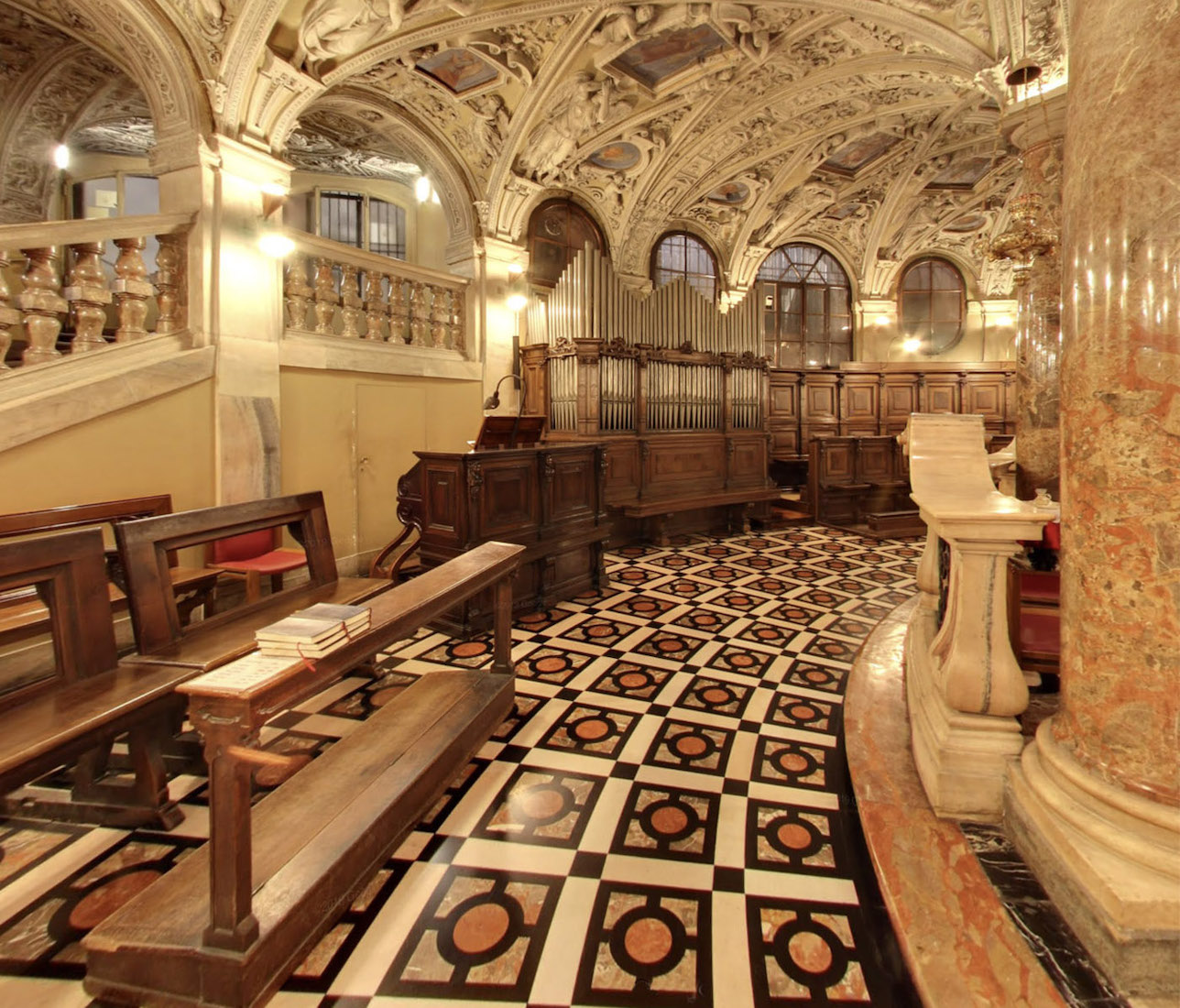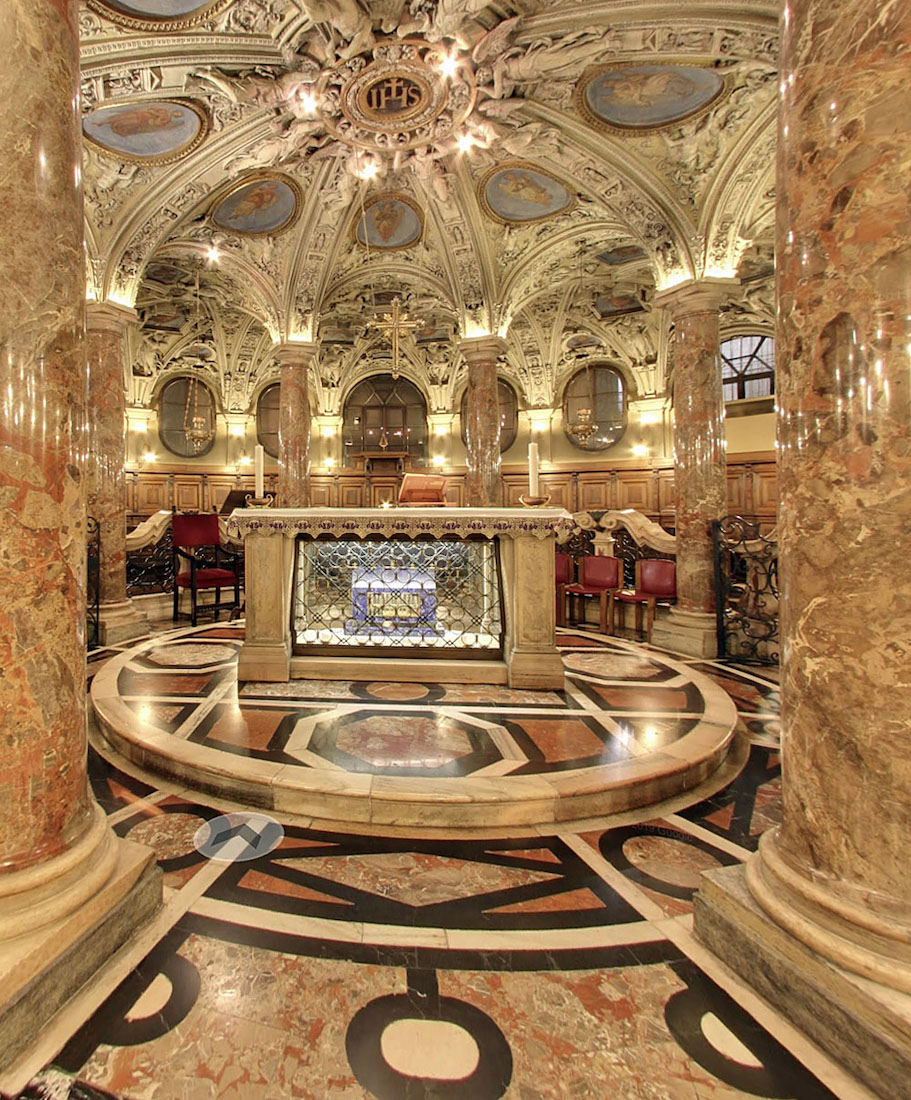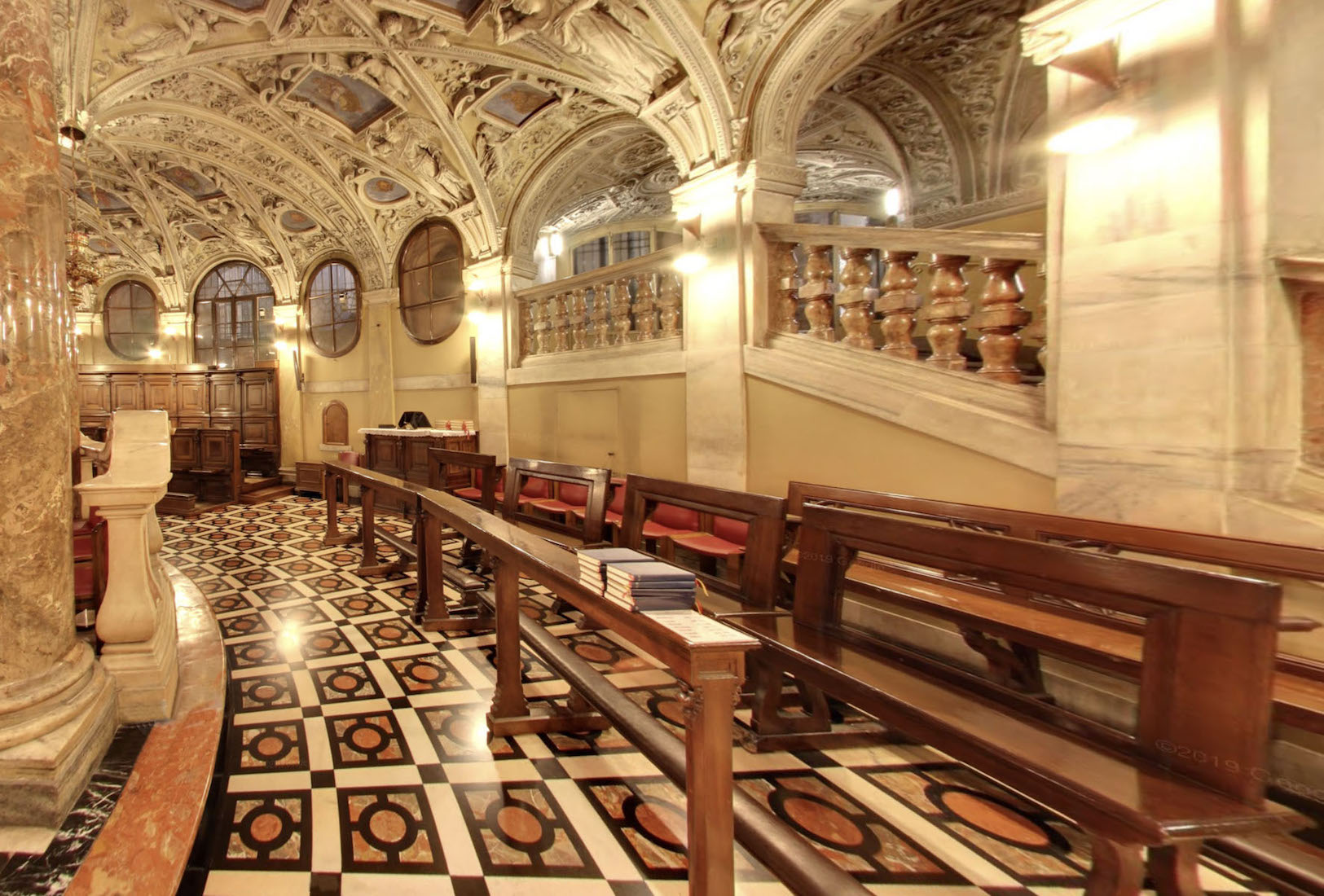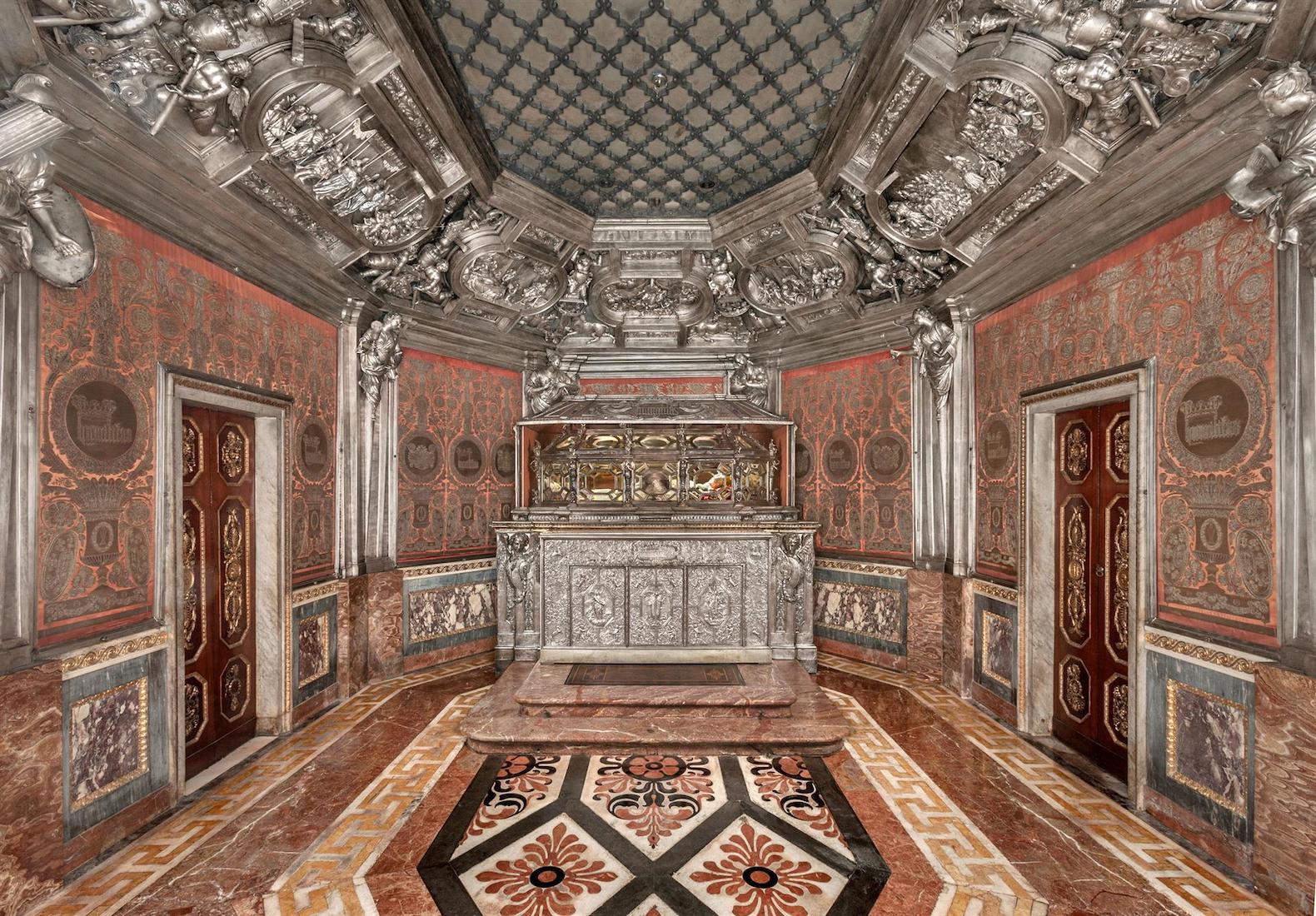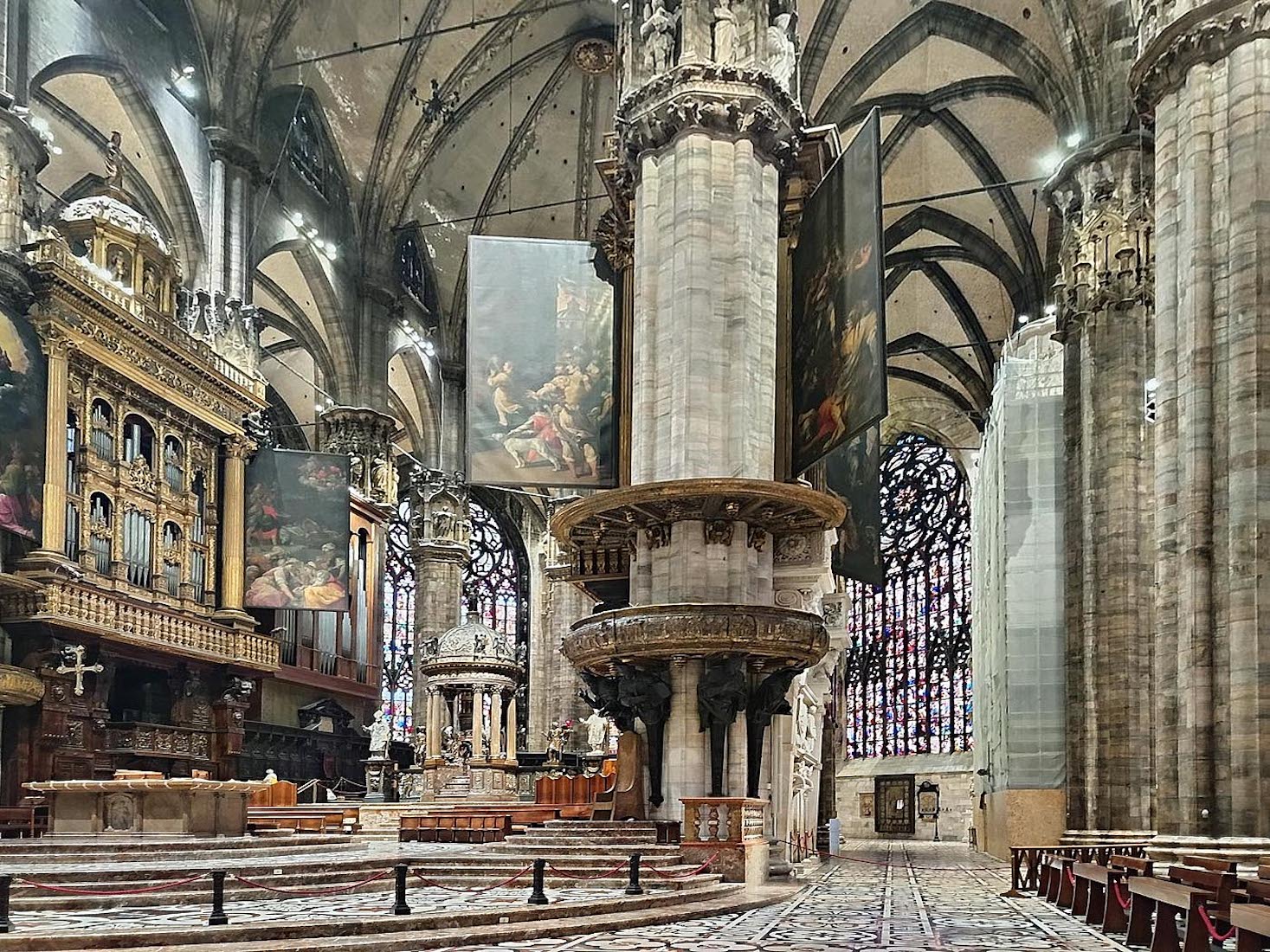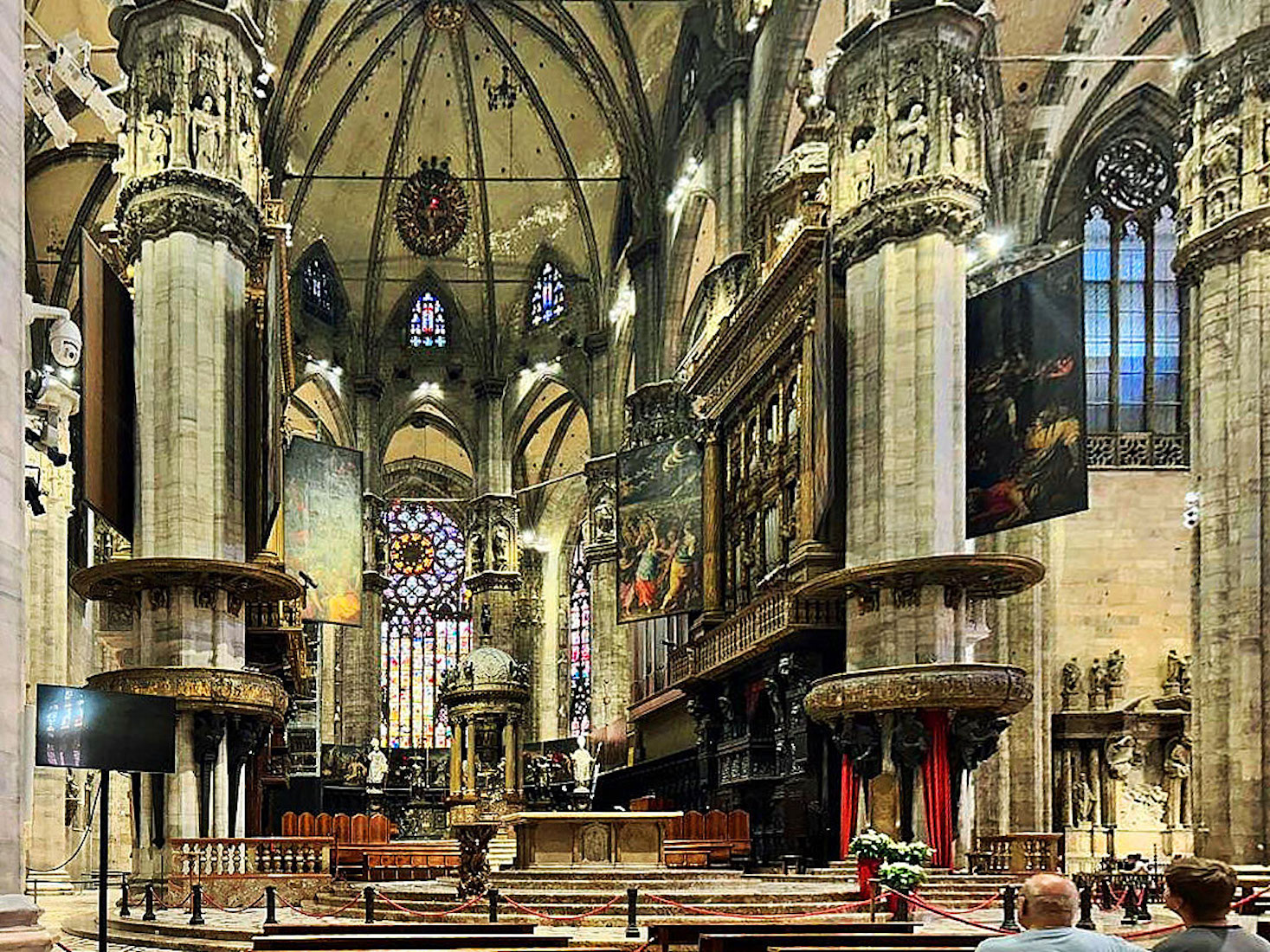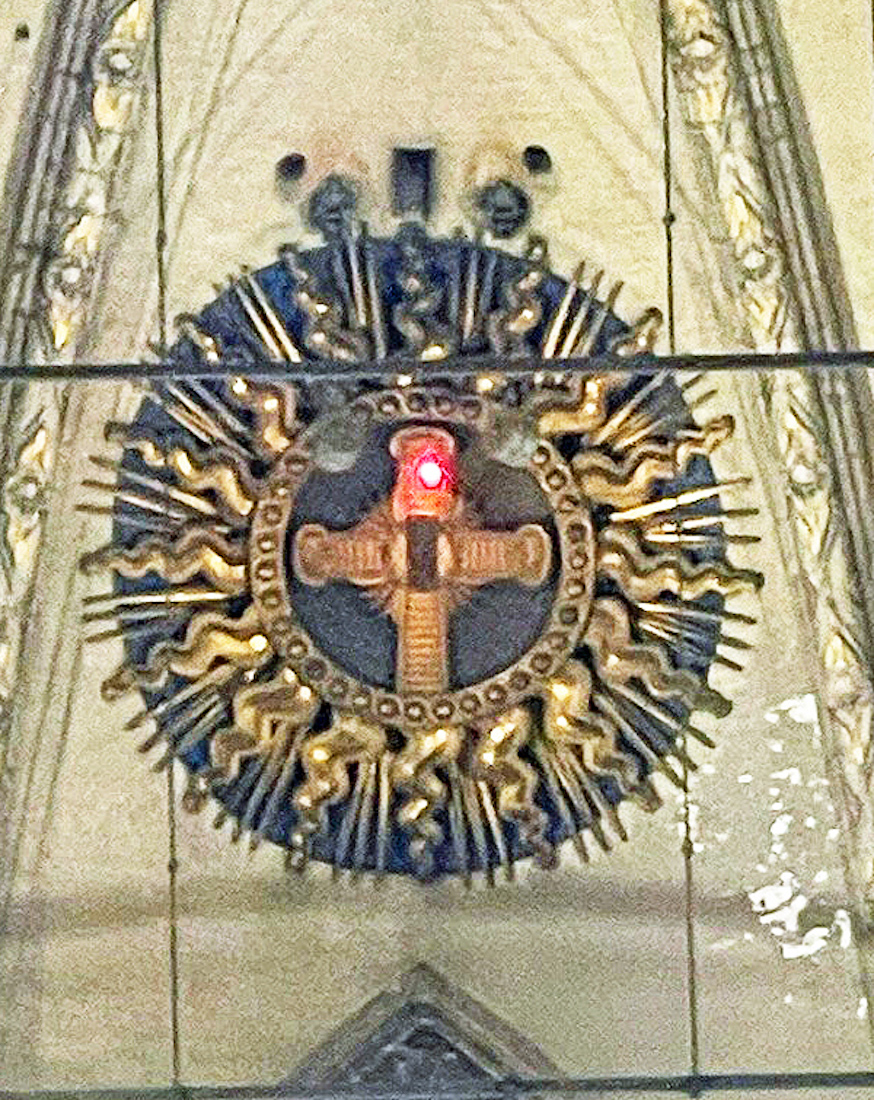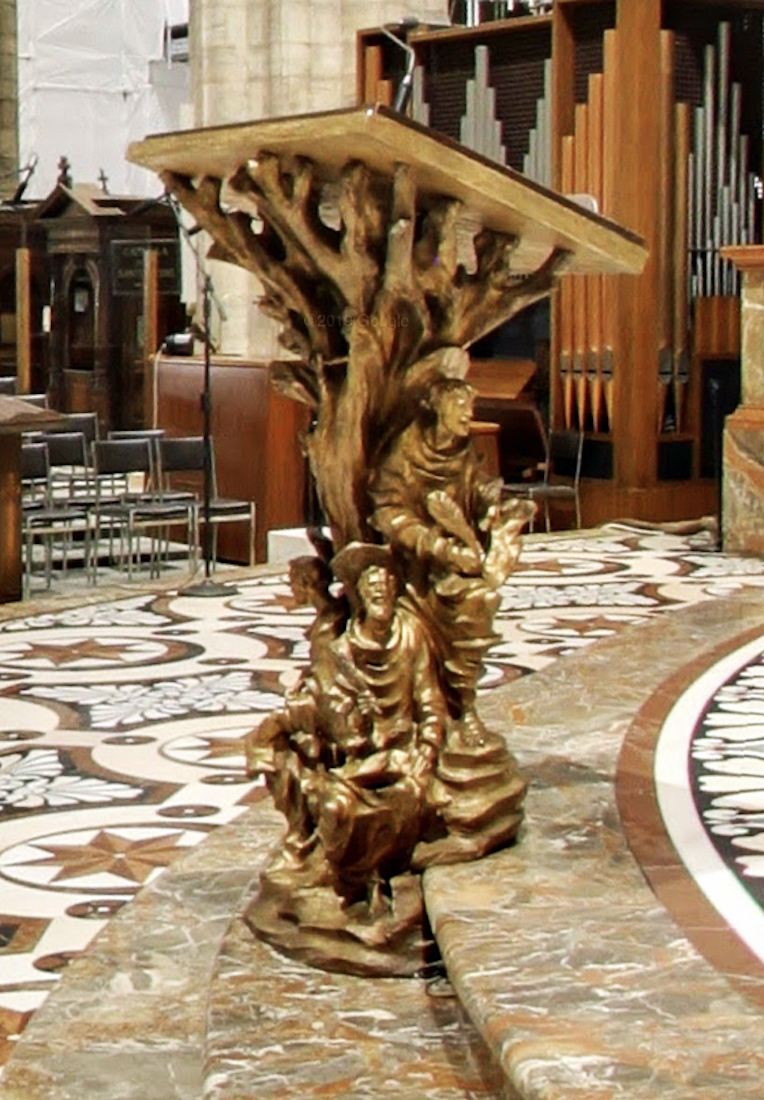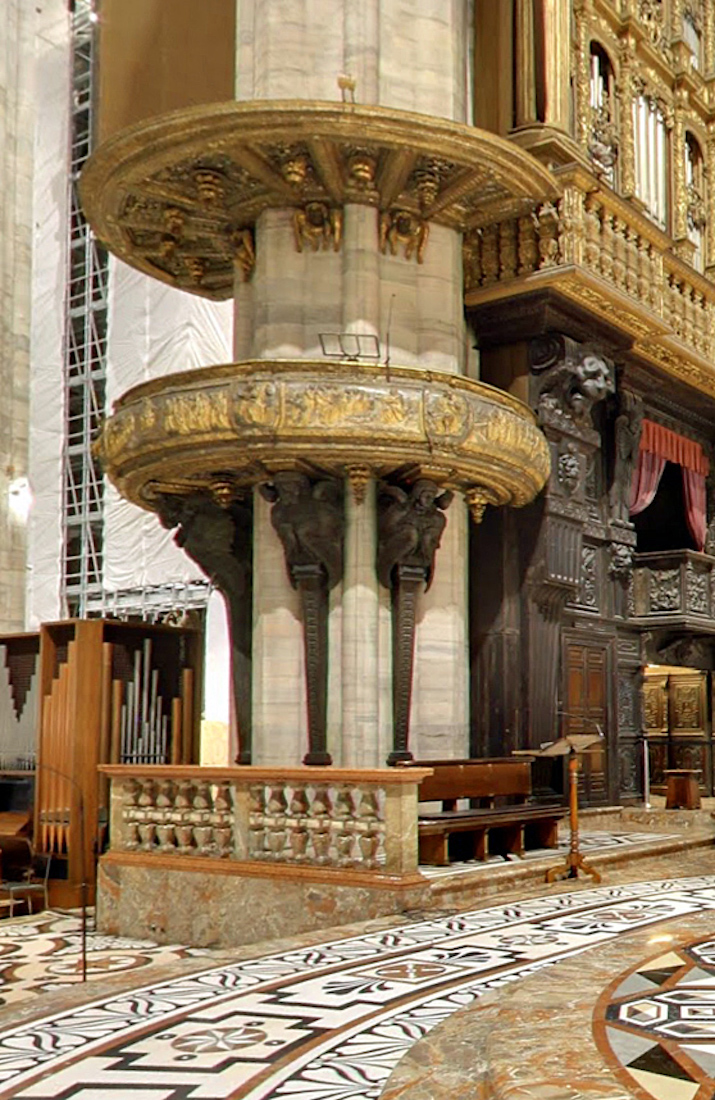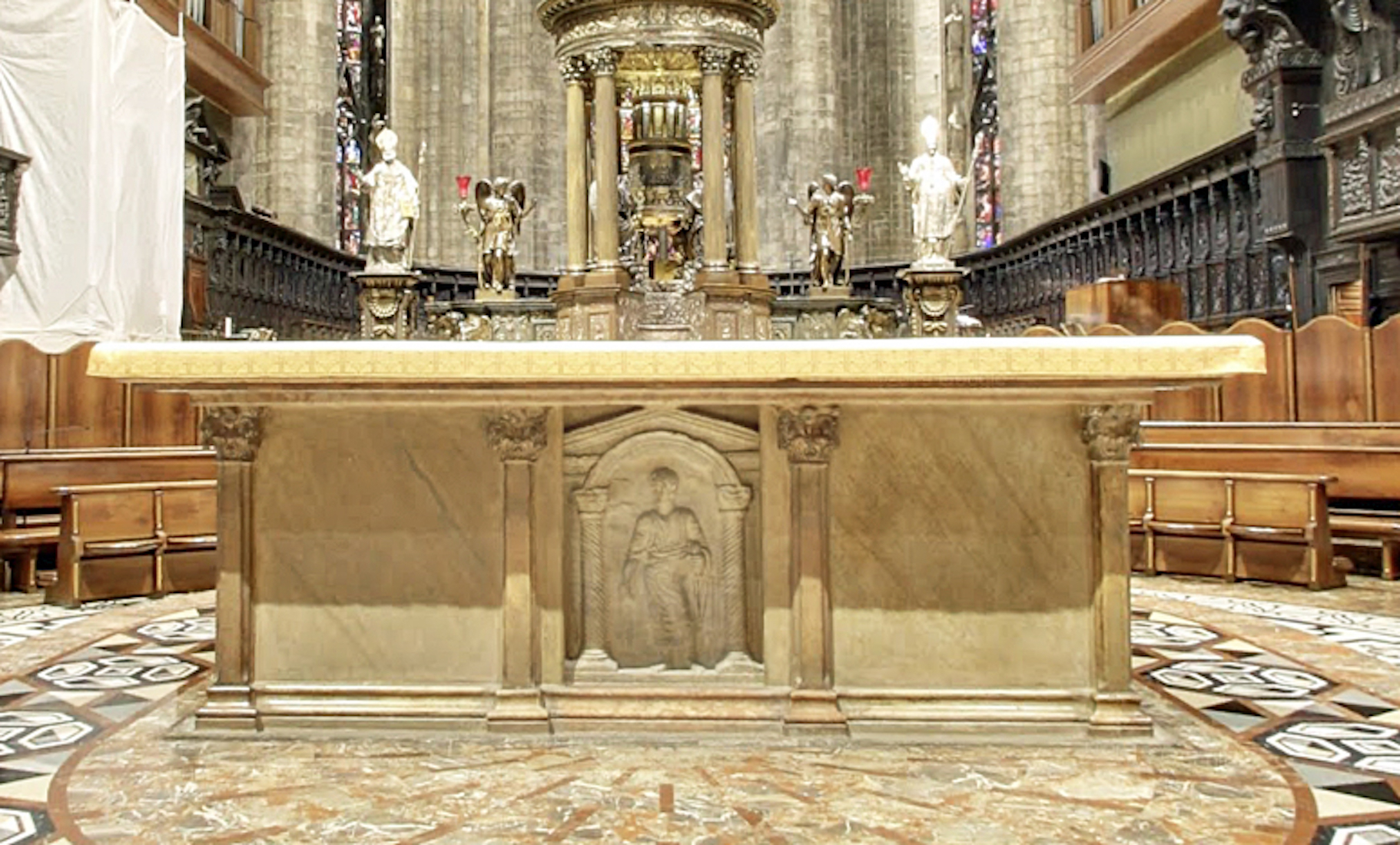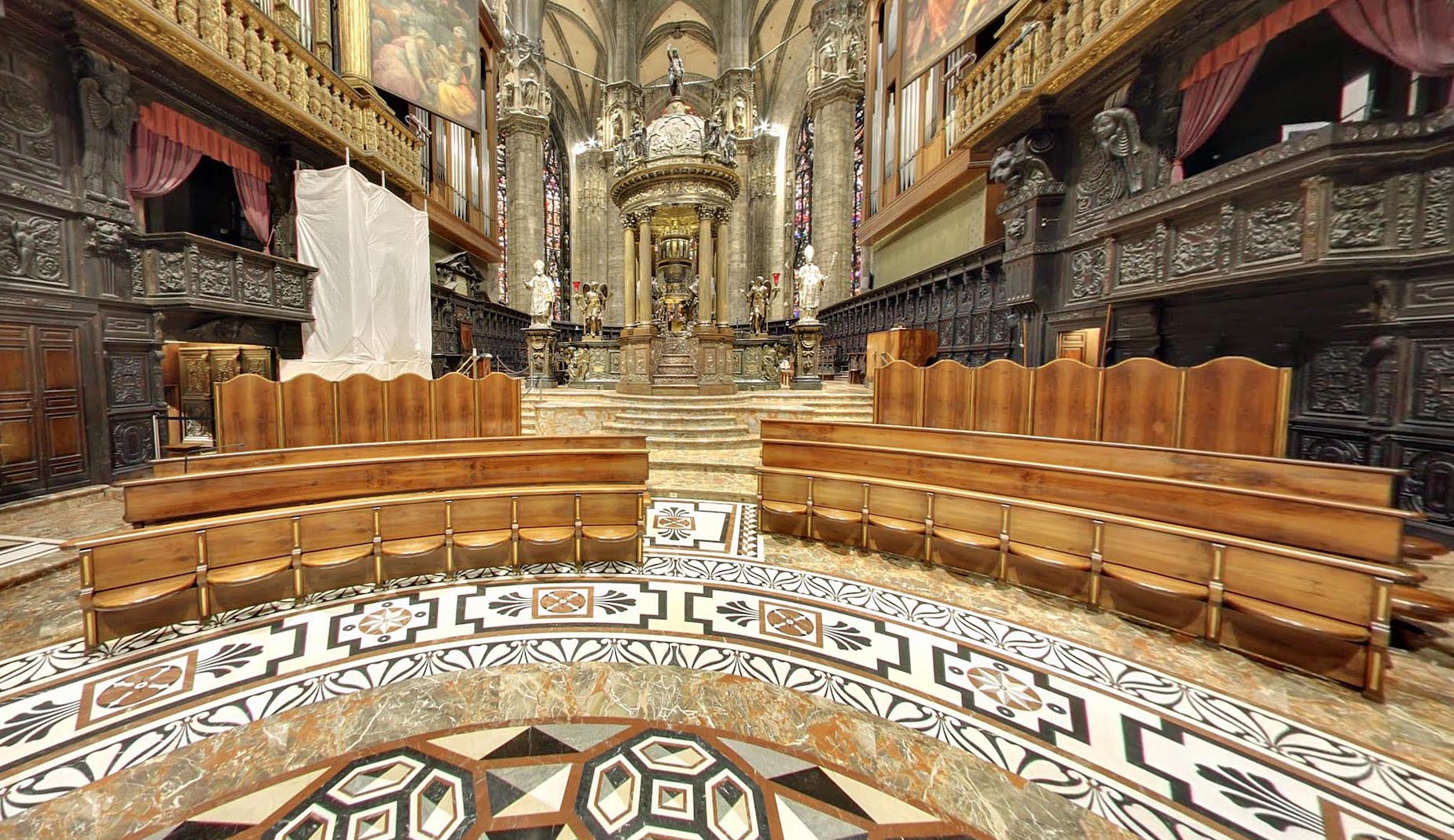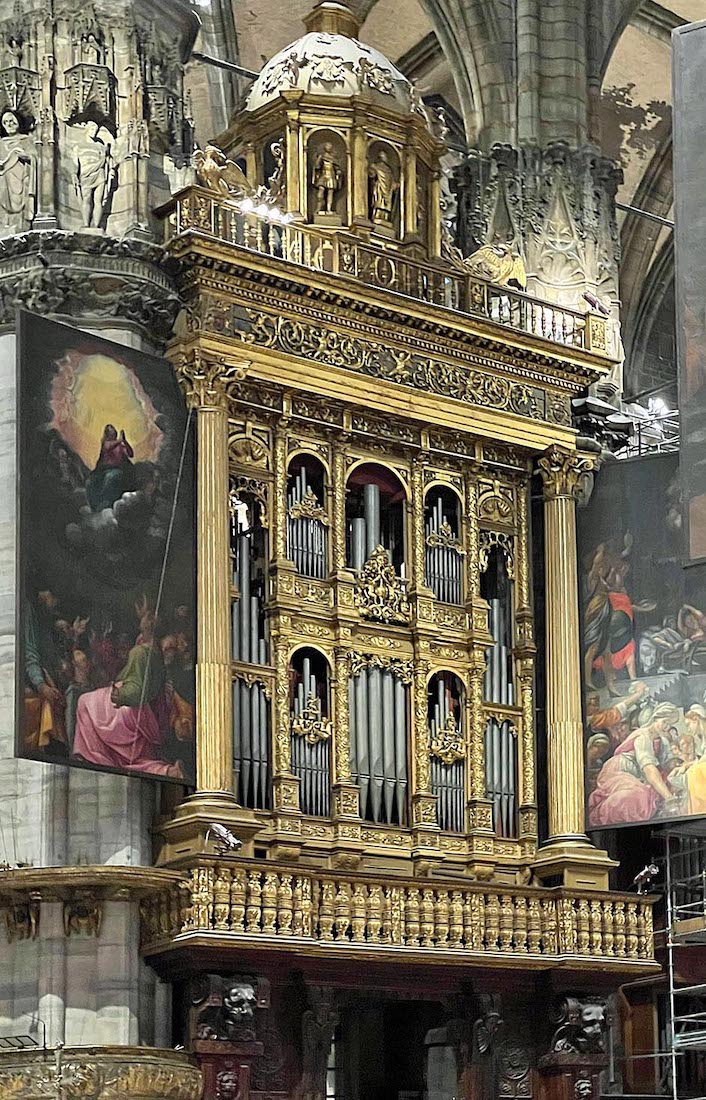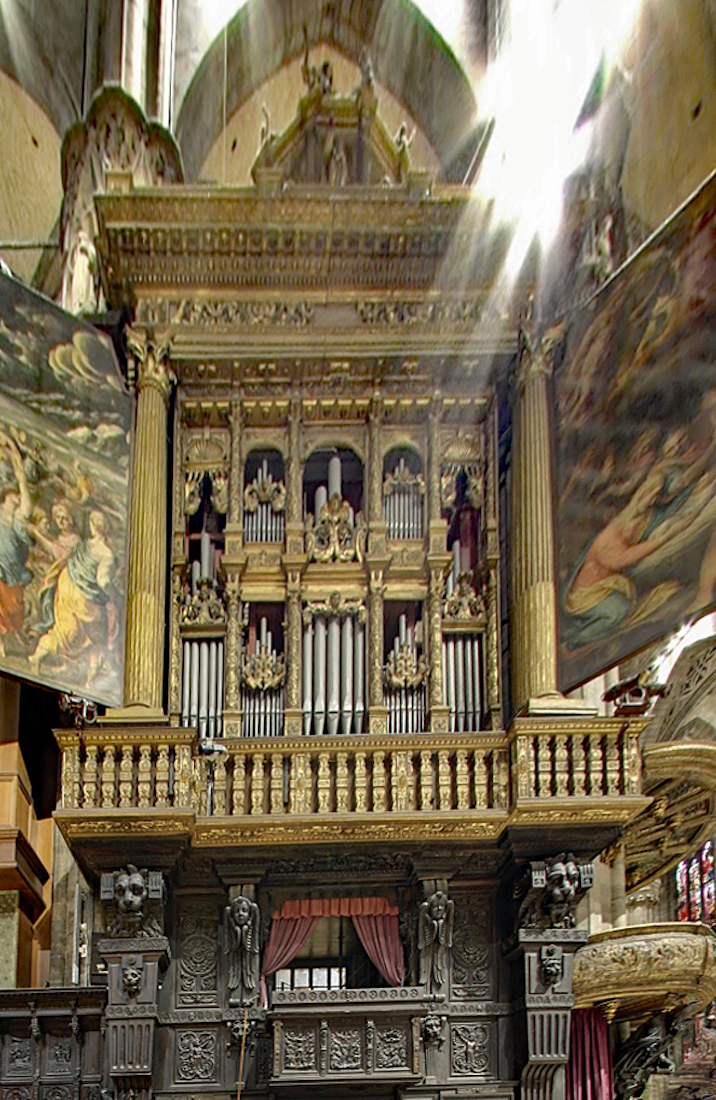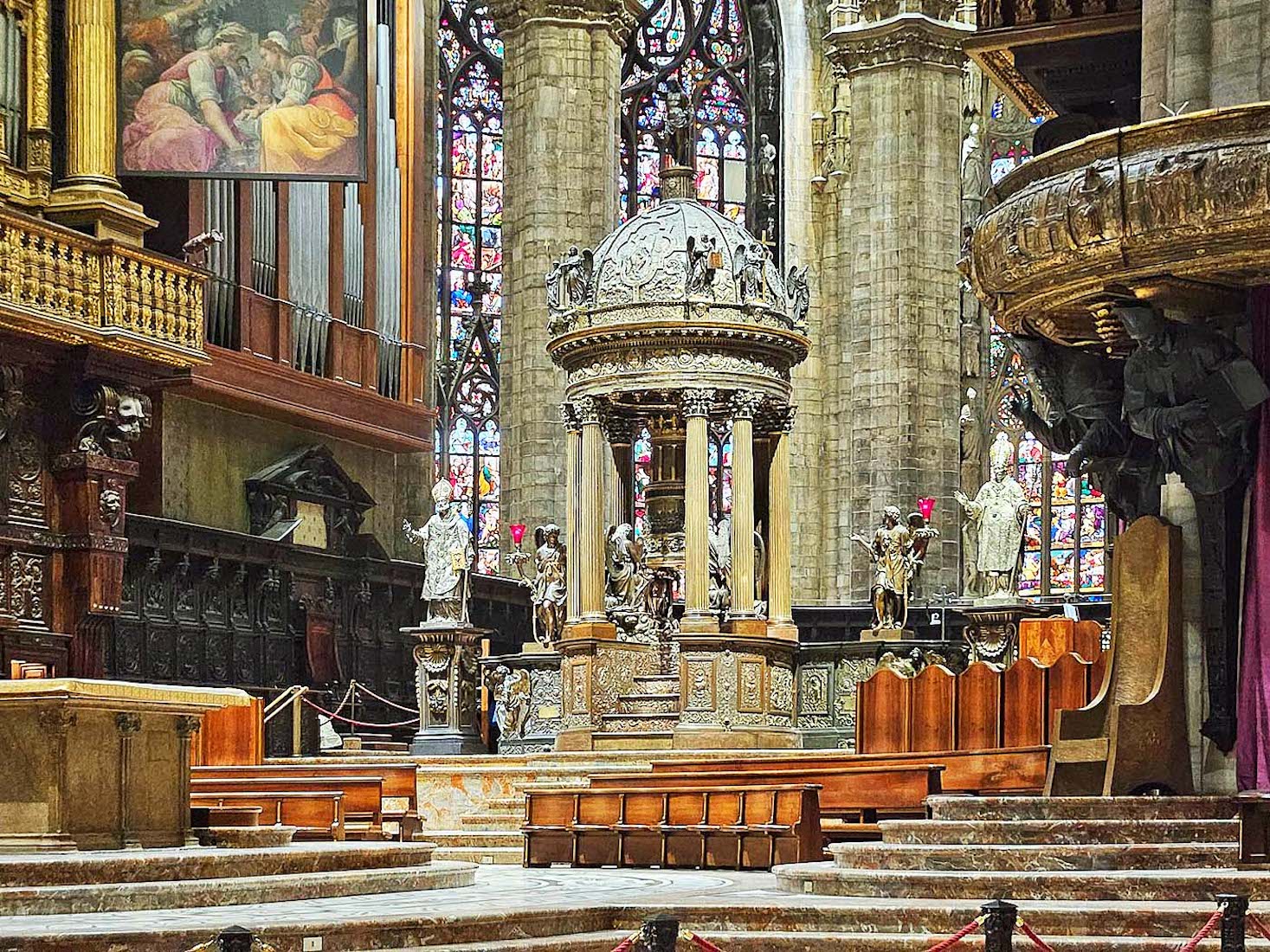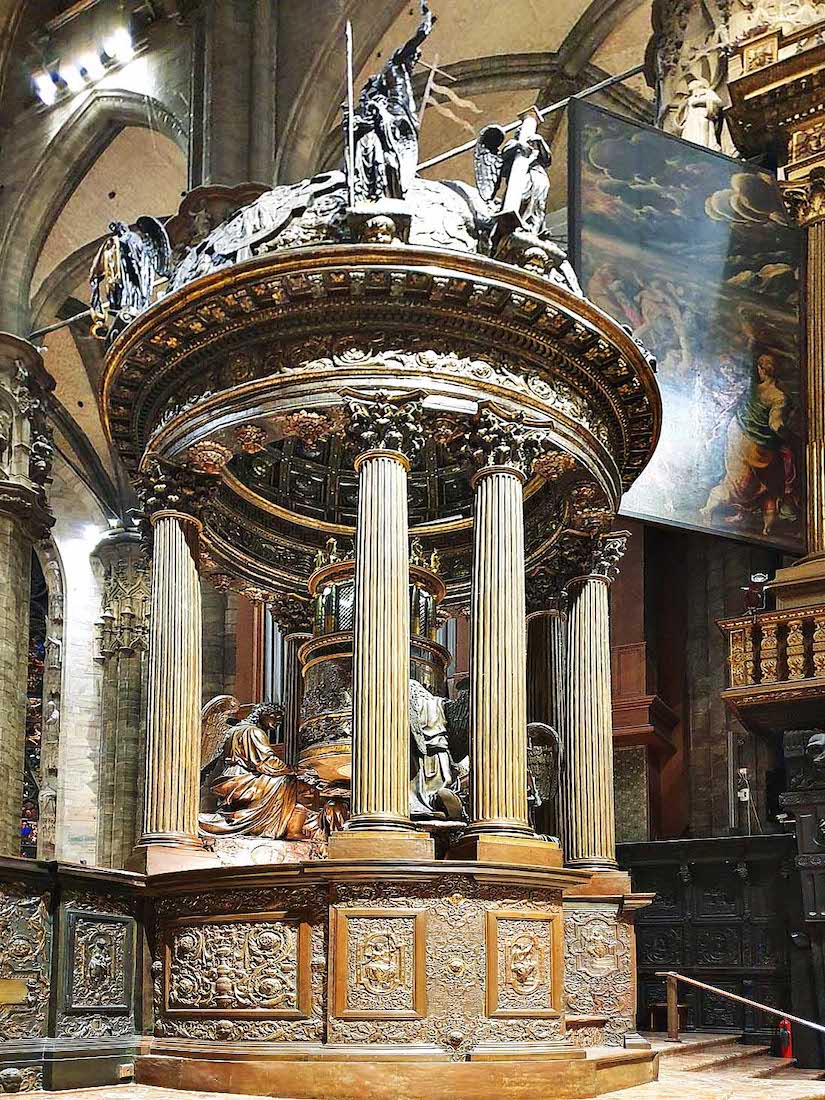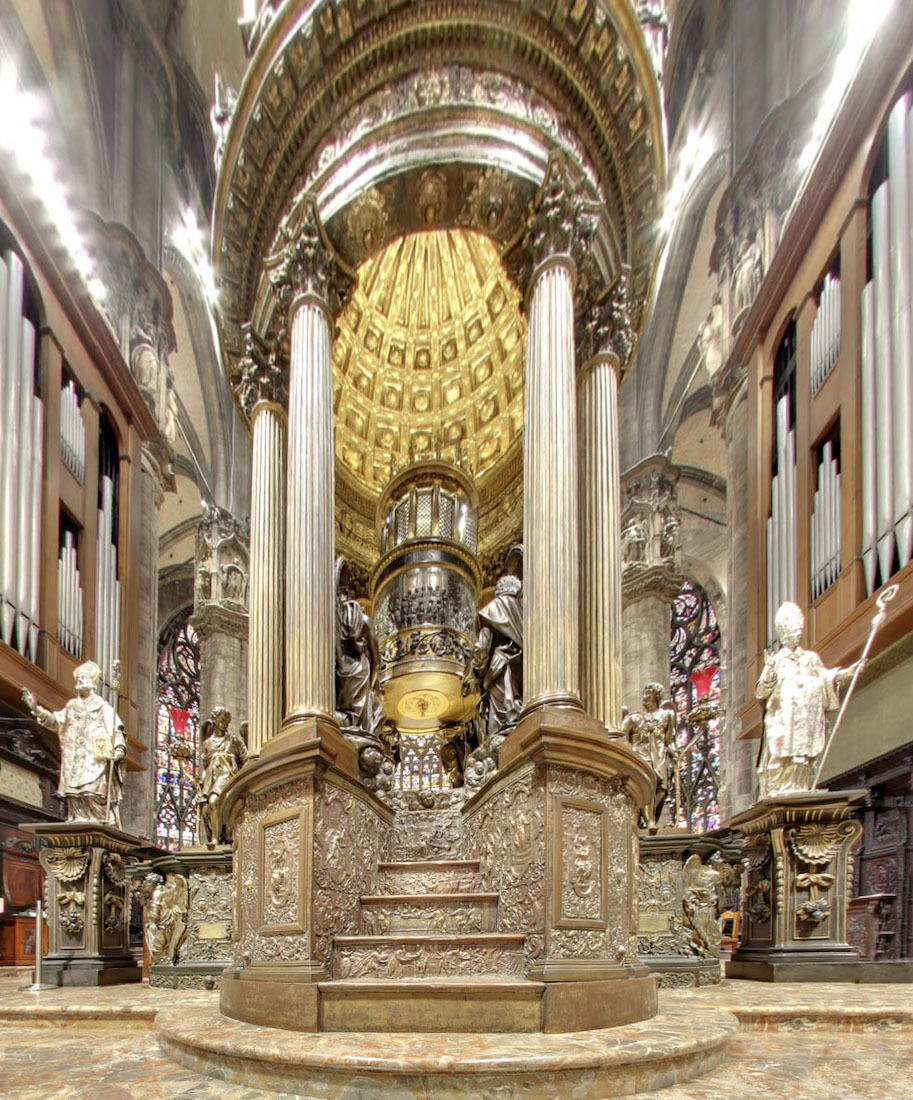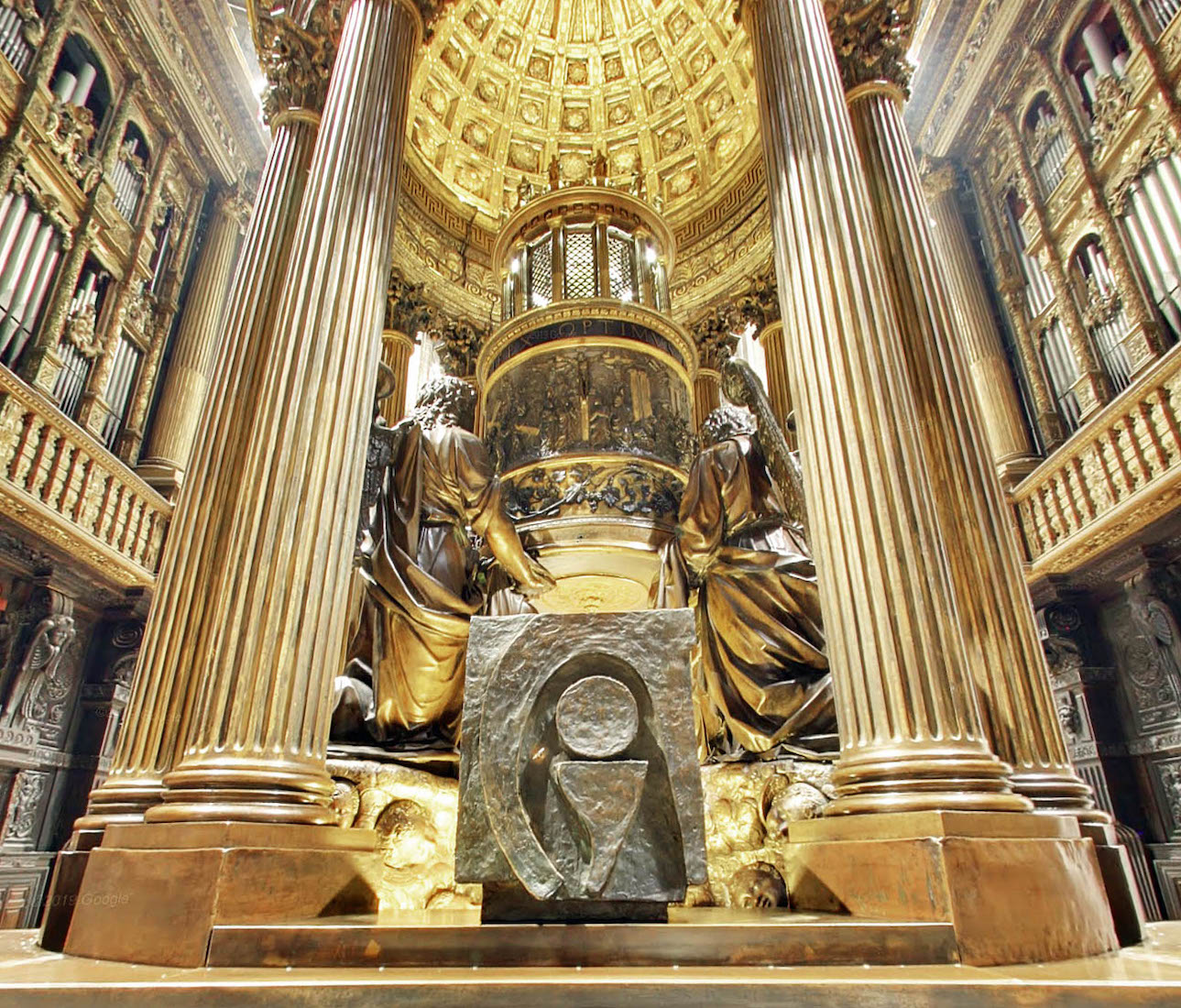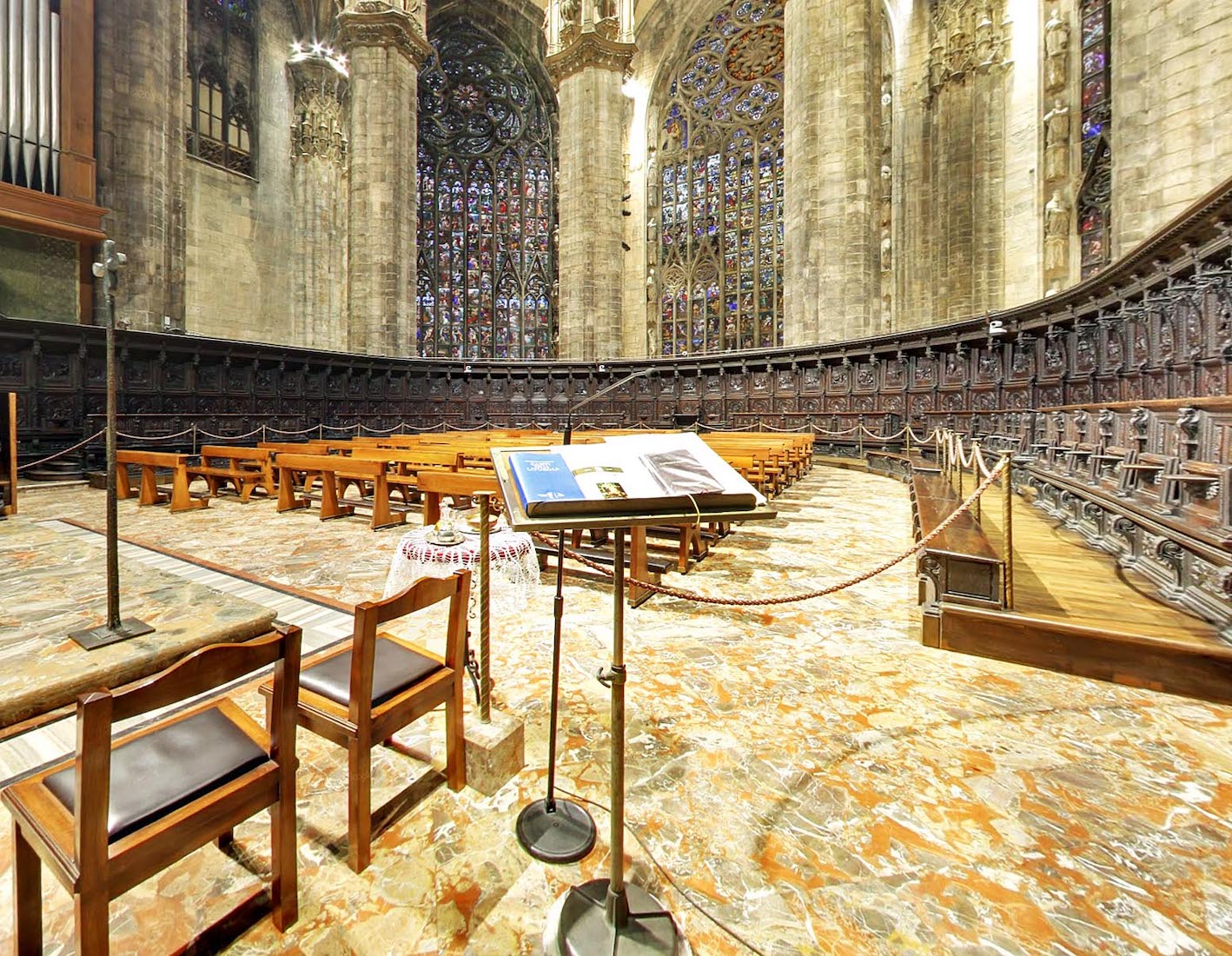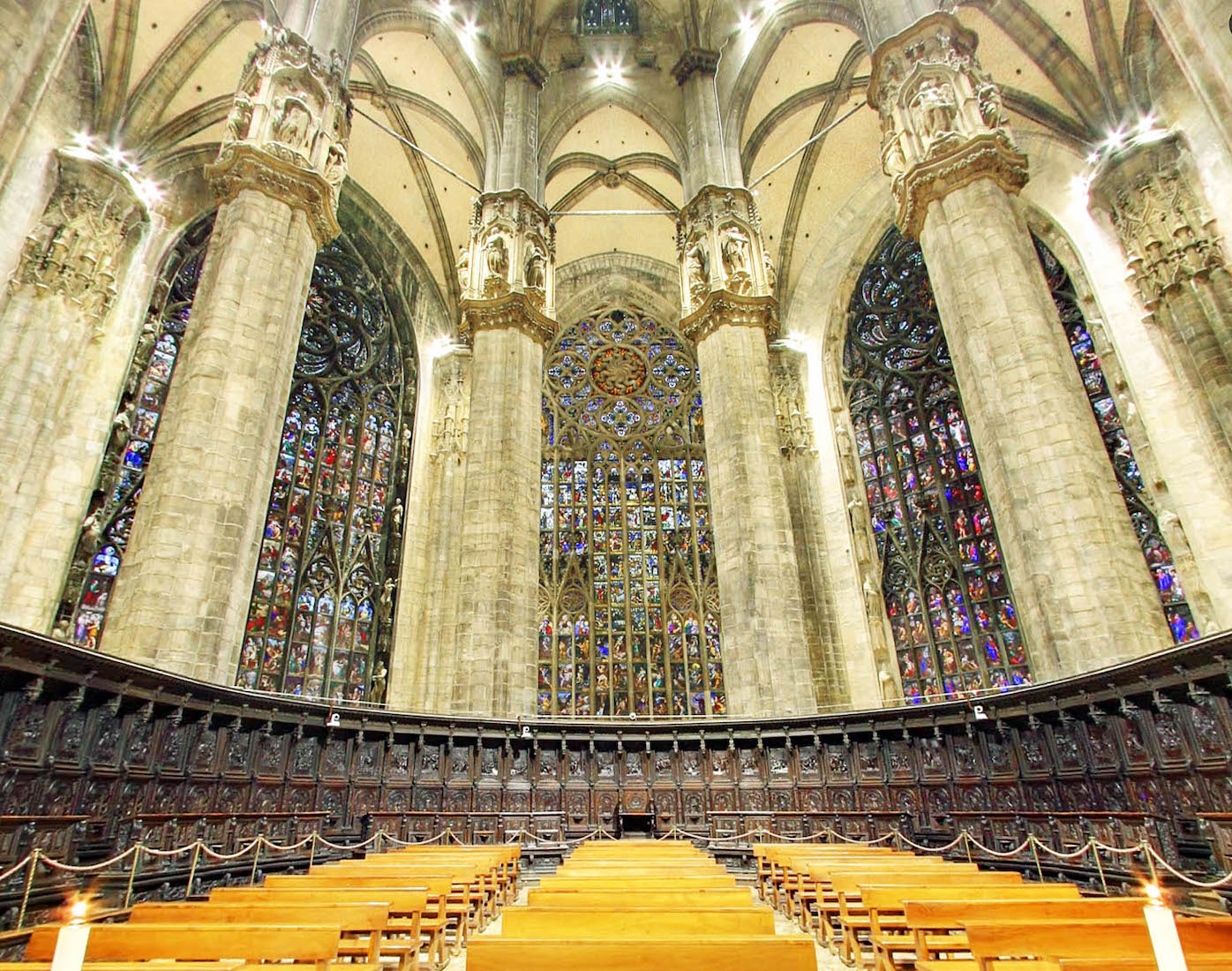C49. INNER WALL OF EAST AMBULATORY GSV TA
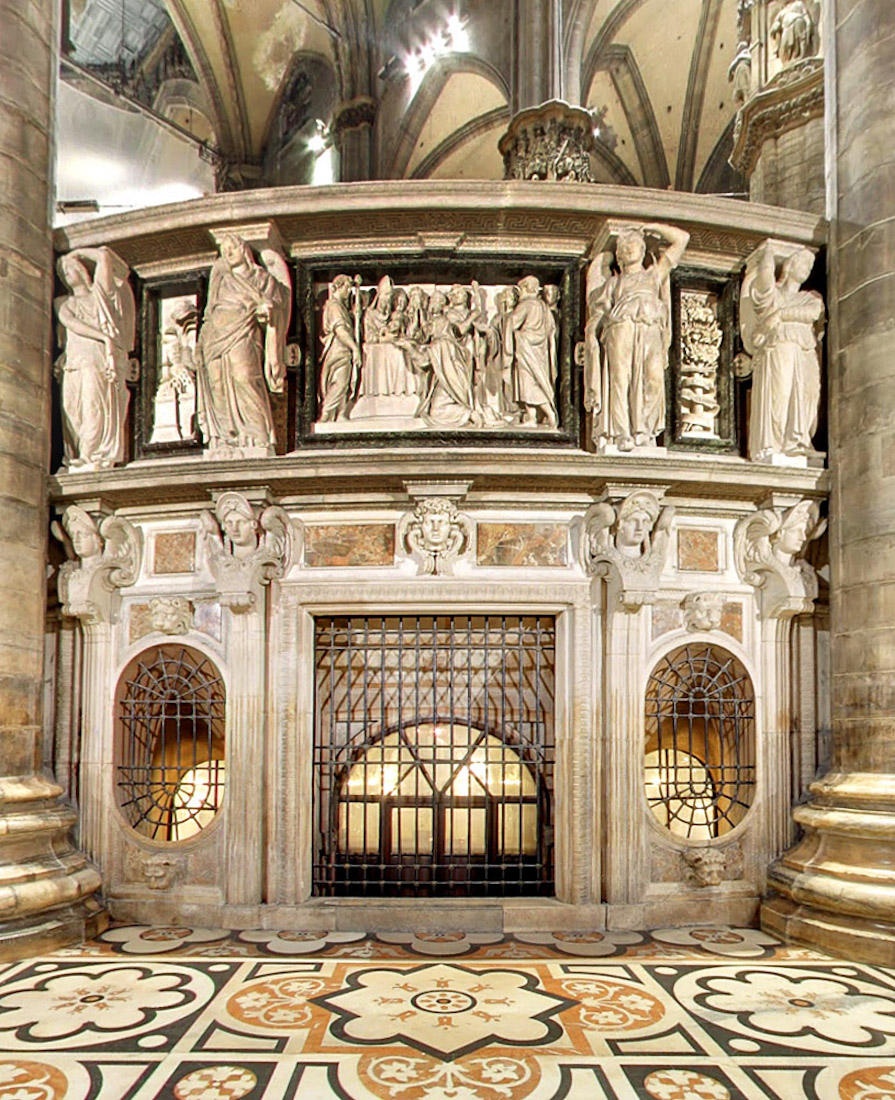
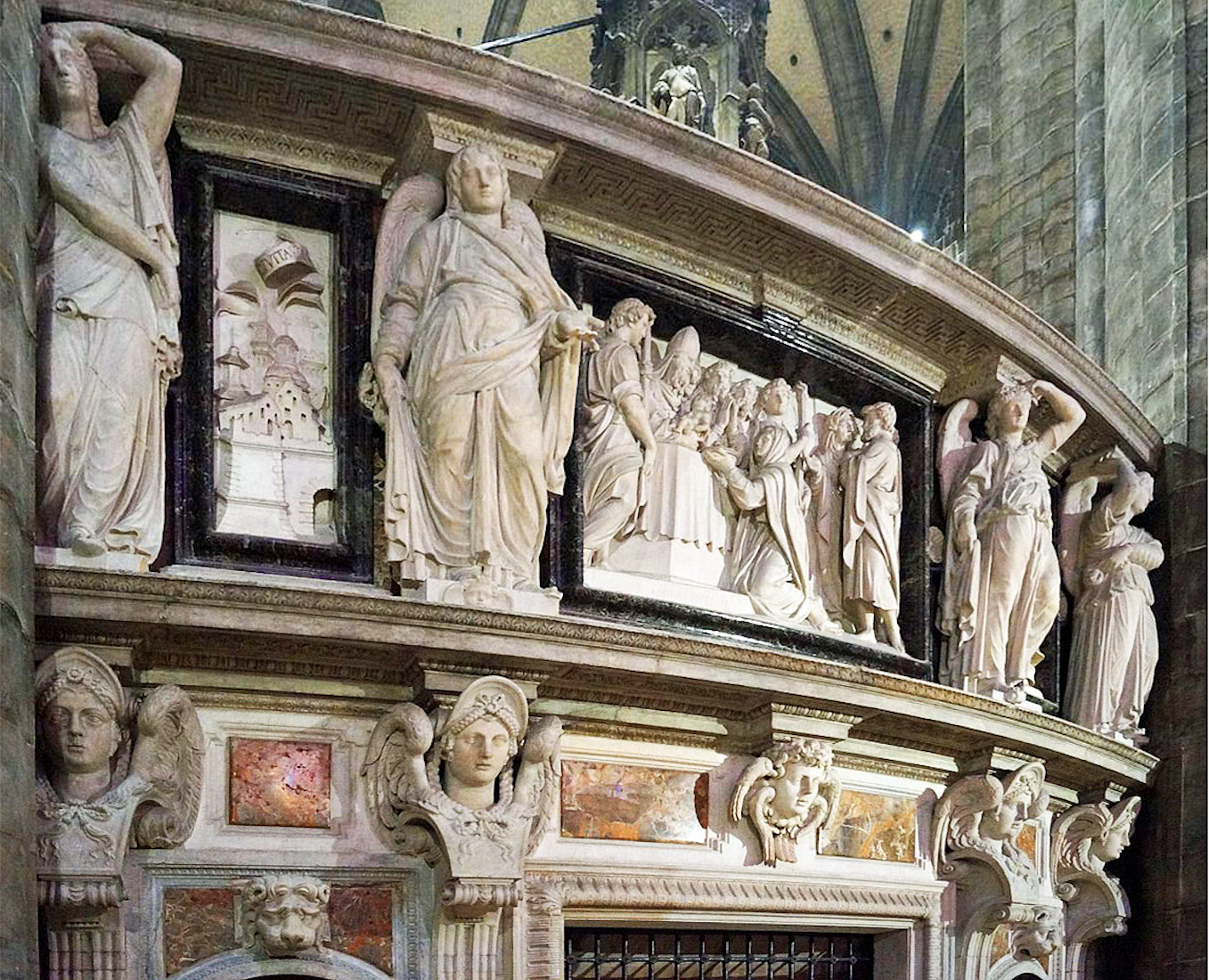
The decoration of the inner ambulatory wall continues to the East end (and beyond), with the sanctuary above on the other side, and the crypt below. [Photo2 Credit: Massimiliano P] INDEX
C50. TO THE SOUTH AMBULATORY GSV
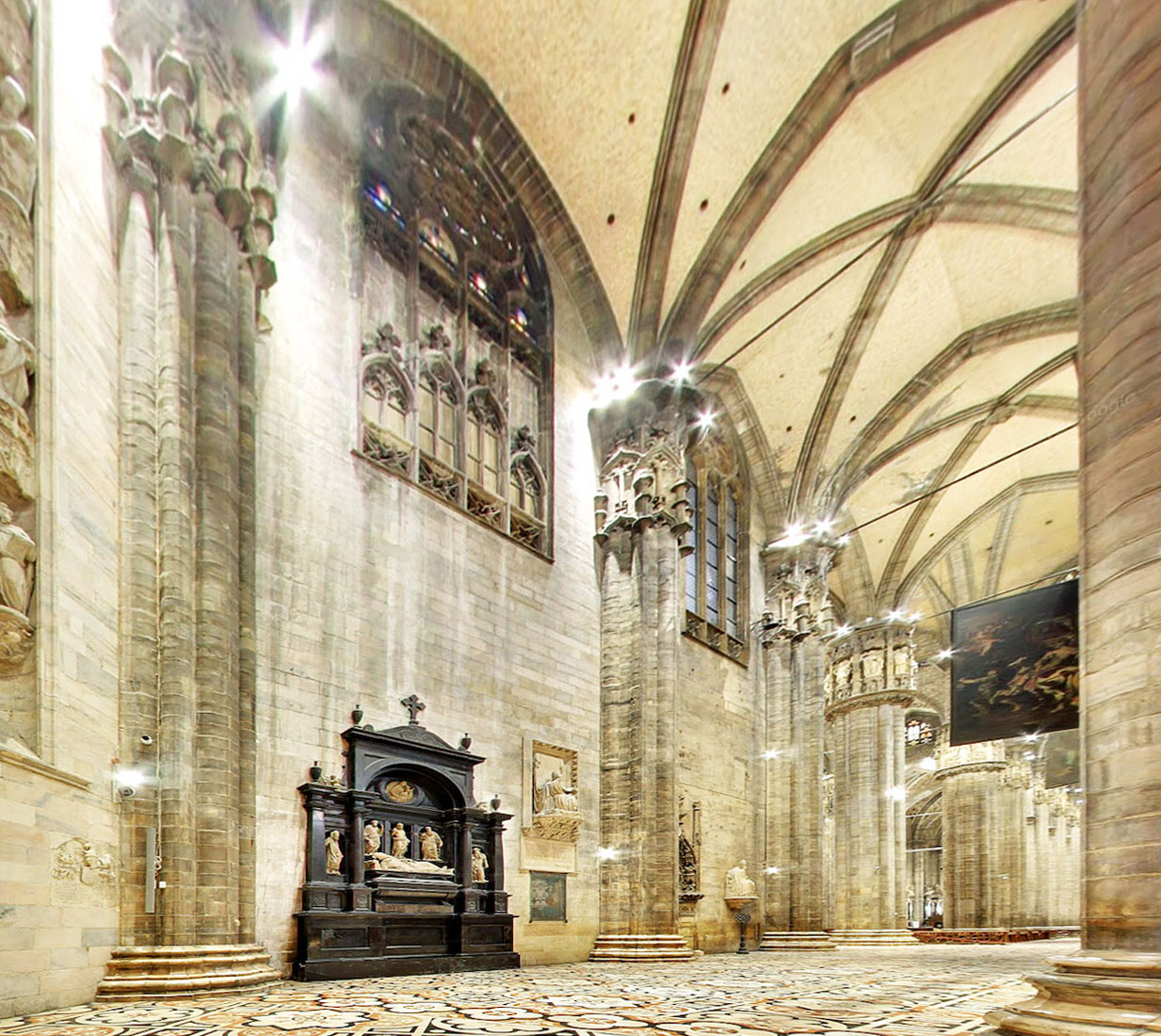
The South ambulatory beckons!
C51. MONUMENTS GSV TA
At left is the funeral monument of Cardinal Marino Caracciolo by Agostino Busti. The monument features a reclining effigy of Cardinal Caracciolo, surrounded by allegorical figures and topped with a relief sculpture. [Photo2 Credit: Massimiliano P]
C52. SOUTH AMBULATORY GSV
The elaborate relief carving above the open South sacristy door appears to show the Risen Christ, the Nativity and the Deposition from the Cross. At right is a statue of Pope Pius XI with a metal candelabra beneath.
C53. CRYPT ENTRANCE AND BACK OF ORGAN GSV
Opposite, on the inner ambulatory wall, there is the back of the organ at right, and at left steps down to the crypt. We take the steps ... [Photo2 Credit ]
C54. CRYPT ENTRY AND ALTAR GSV TA
The steps lead down to an impressive round vaulted area, with a central altar. The altar contains sacred relics of Saint Charles Borromeo and is surrounded by eight Tuscan columns. The crypt is known as ‘the Jemale Chapel’ (‘Winter Chapel’ in ancient Italian), and was designed in the 16th century by Pellegrino Pellegrini. [Photo2 Credit: MGiL]
C55. CRYPT GSV X3
We stand back and take some time to appreciate the symmetry and beauty of this Chapel. The Chapel’s vaulted ceiling is embellished with a refined stucco decoration and a fresco depicting symbols of the Eucharist, the Passion, and angels.
C56. SCUROLO OF ST CARLO CP
Directly behind us, on the Western side of the crypt, is a door leading to the ‘Scurolo di San Carlo’, which houses the remains of Saint Charles Borromeo. The term itself, derived from Milanese dialect, means a dimly lit or underground space. [Cathedral Photo]
C57. CHOIR AND SANCTUARY TA TA
Emerging from the crypt, we walk around to the crossing and face the choir and sanctuary. The Cathedral features a prominent pulpit used for readings and sermons. It is positioned on the left, high on the massive columns surrounding the altar, offering a unique perspective during services. •• There is also an item here which is easily missed. We see it in the second view: high up, a hanging round object with a central cross and red light. [Photo Credit: Célia C] [Photo Credit: Ismeniag2016]
C58. HOLY NAIL TA
Stored here is the Holy Nail. This is considered a very important relic in the Archdiocese of Milan. It is believed to be one of the nails used in the crucifixion of Jesus, discovered by Saint Helena, mother of Emperor Constantine. The relic is normally housed in a tabernacle located high above the main altar, close to the ceiling of the Duomo, about 40 metres above the floor. It is marked by a red light. Each year, during the September feast of the Exaltation of the Cross, the ‘Rito della Nivola’ takes place. The Archbishop uses a cloud-shaped lift, the Nivola, to ascend to retrieve the Holy Nail. The Nivola is a 17th-century structure decorated with cherubs and angels. After various ceremonies, the Holy Nail is returned to its tabernacle. [Photo Credit: Thomas R]
C59. LECTERN, PULPIT GSV GSV
On the North side of the crossing stands an elaborately decorated golden lectern. The reading platform is supported by branches of a tree – the tree of life?
C60. NAVE ALTAR GSV
The nave altar is the centre of worship for the Cathedral, and it is from here that the Eucharist is administered. When Vatican II met in the 1960s, there was a resolution that a nave altar would be used. One of the arguments was that the celebrant would then be close to the congregation. They didn’t have Milan Cathedral in mind!
C61. CHOIR STALLS GSV
Behind the nave altar are two curved sets of choir stalls. Milan Cathedral features a renowned choir, the ‘Cappella Musicale del Duomo’, with a history spanning six centuries. This choir is known for its performances during solemn Masses and vespers, held every Sunday. Additionally, the Cathedral frequently hosts concerts featuring various choirs, both local and international.
C62. ORGAN PIPES TA GSV
The Cathedral organ is the largest in Italy and one of the largest in the world. It boasts 15,800 pipes, five organ cases, and five consoles, with pipes ranging from a few inches to over 30 feet long. The organ’s artistic aspects include an exceptional timbre for romantic-symphonic repertoire and panels depicting scenes from the Old and New Testaments on the Renaissance organ cases. [Photo1 Credit: Angelo S]
C63. SANCTUARY TA TA
Behind the choir stalls is the sanctuary with its massive high altar. There are two statues here. To the left of the high altar is the famous statue of Saint Bartholomew Flayed, created by Marco d’Agrate in 1562. To the right of the altar is the funerary monument to Gian Giacomo Medici di Marignano, also known as ‘Medeghino’, sculpted by Leone Leoni. [Photo Credit: Susan E]
C64. HIGH ALTAR TA GSV
The high altar was brought from the Santa Maria Maggiore Basilica, one of two pre-existing basilicas, when the Duomo was being built. It is situated in the presbytery, a section of the church reserved for the clergy, and is accessed by the central nave. The altar is a substantial block of brocatelle marble. A plaque featuring a man holding a scroll, believed to be part of a 3rd-century Roman Sarcophagus, is found in the centre of the altar. Pope Martin V consecrated the altar on October 16, 1418, signifying the start of religious services in the new cathedral. [Photo1 Credit: CONCETTA P ]
C65. TABERNACLE DETAIL GSV
The tabernacle proper is topped by an image of Christ Resurrected (not visible here) and what is likely the figures of the twelve apostles encircling Him. Found near the base of the tabernacle is a depiction of the Last Supper. We can see two of the four supporting angels.
C66. RETROCHOIR GSV
Behind the high altar is the retrochoir. The term refers to this general area, or more specifically to the surrounding wooden choir stalls constructed by Francesco Brambilla around 1614. The purpose of these stalls was to provide seating for the clergy and choir during services, specifically behind the altar in the chancel area. I am reminded of the chapter house settings in cathedrals which have chapter houses.
C67. RETROCHOIR AND APSE GSV
We conclude our visit to Milan Cathedral with the spectacle of the retrochoir in the apse setting.
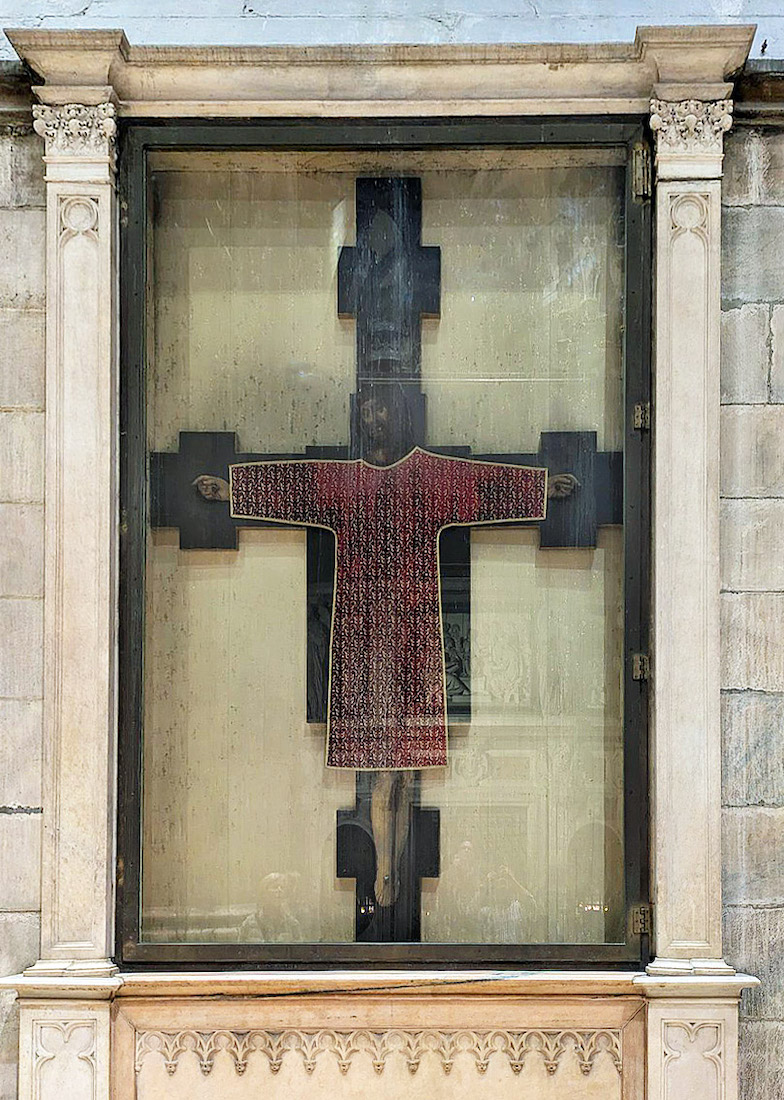
TA Angelo S
CONCLUSION
I hope you have enjoyed visiting Milan Cathedral as much as I have. It is definitely a great Cathedral!
As mentioned in the Index, none of the photos on this site are mine. Photographs have been taken from Wikimedia [Wiki], Google Street View [GSV] and Trip Advisor [TA]. It is simply not possible to trace the contributing photographers from these sources. So in the text, the source and the name of the photographer is included for each photo. I hope that contributors will be happy with this arrangement, and pleased to help others enjoy this wonderful Cathedral. If there is a problem, please contact me at the email address below. The source links are:
https://commons.wikimedia.org/wiki/Category:Duomo_(Milan)
Trip Advisor: Look under ‘Things to do’.
We note that many of the Google Street View photos are unacknwledged. This is because they are edited screen shots taken from the excellent GSV walk-through of this Cathedral. Much appreciated just the same!
I take little credit for the text which comes from a variety of different sources.
I also express my thanks to my wife Margie who dutifully reads through all my websites and checks the typing.
I would be glad to receive any comments, criticisms or corrections to this site. The best websites are those which contain no errors!
Site created 07 / 2025
Paul Scott

